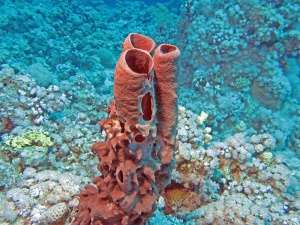Phylum porifera

Background
- Also known as "sponges"
Life and Habitat
- Approximately 5000 species of sponge
- Generally stationary and attach to see floor or coral beds
Relevant species
- Most common Tedania ignis (Hawaiian or West Indian fire sponge)
- Found in Florida and Hawaii
- Fibula nolitangere (poison bun sponge)
- Microciona prolifera (red moss sponge)
Clinical Features
- Symptoms caused by contact with sponge
- Pruritic dermatitis and rarely erythema multiforme or anaphylactoid reaction
- Reaction appears between 10 minutes and a few hours of contact
- Starts with pruritus and burning
- Mild reactions resolve in 3-7 days
Differential Diagnosis
Marine toxins and envenomations
- Toxins
- Stingers
- Venomous fish (catfish, zebrafish, scorpion fish, stonefish)
- Cone shells
- Lionfish
- Sea urchins
- Nematocysts
- Coral reef
- Fire coral
- Jellyfish (Cnidaria)
- Portuguese man-of-war
- Sea anemones
- Phylum porifera (sponges)
- Bites
Evaluation
Management
- Gently dry skin
- Attempt to remove small spicules embedded in skin
- May use adhesive tape
- Use 5% acetic acid (vinegar) soaks to affected area 10-30 minutes 3-4 times daily
- If unavailable may use 40-70% isopropyl alcohol
- Topical steroids may relieve secondary inflammation
- Tetanus prophylaxis
- Close follow up for wound checks to monitor for infection
Disposition
See Also
External Links
References
- Auerbach PS, DiTullio AE. Envenomation by Aquatic Invertebrates. In Auerbach PS, Cushing TA, Harris NS. Auerbach’s Wilderness Medicine. 7th ed. Philadelphia, PA: Elsevier; 2017: 1679 – 1682.
This article is issued from
Wikem.
The text is licensed under Creative
Commons - Attribution - Sharealike.
Additional terms may apply for the media files.